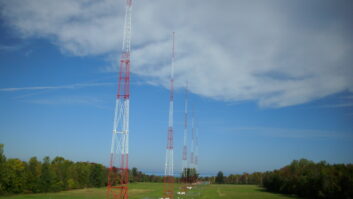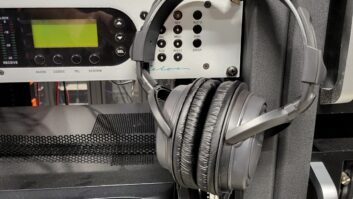My brother John knows my affinity for old radios, and he gave me an old Philco tabletop last year. It’s a Model 41-221. The “41” denotes the year of manufacture, which makes the radio 73 years old, about 20 years shy of being as old as the medium it was built to receive, using the licensing and broadcasts of KDKA as its birthdate.
I love the thing, and my grandsons are fascinated by it. My oldest, Isaac, shown right, age 8, had the best question so far. “Hey Grandpa, what are those little orange lights inside?”

Curiosity about vacuum tubes aside, this little (for its time) AM radio, with its dimly lit dial and dusty tubes, got me thinking about the events and programming AM radio has brought to the masses over the years.
The Philco Corporation made several dozen radio models in 1941 and most sold quite well. The Model 41-221 was advertised for $23.50, and according to information at www.philcohistory.com, 37,116 were sold. Higher-end floor model radios from the company sold for up to $250.
The company also built battery-operated models for rural listeners, who often had no commercial electrical service. Battery-operated radios are common enough today, but in 1941 they were a big deal, since Bell Labs was still six years away from inventing the transistor.
Battery-operated tube-type radios used as few tubes as possible because tubes are “thermionic” devices; they only conduct and amplify when heated up.
In other words, they are power hogs. Four-tube battery sets were common, and they needed at least two batteries to work: a 6 volt “A” cell (about the size of a modern lantern battery) to power the filaments, and a “B” battery, which output 90 volts or more, to provide “high” voltage to the plates of the tubes. The whole deal was good for about 20 hours of listening before the Sears Wish Book had to come out and batteries were reordered. (A bit of trivia: Even today, electronic circuits that use tubes refer to high voltage as “B+”, in reference to the B batteries that powered early equipment.)
AM radios of the time often included the ability to receive shortwave broadcasts, and the 41-221 had that feature. The rotary dial shows recommended frequencies for receiving London, Paris, Berlin, Rome and curiously, considering the increasing likelihood of war in the Pacific in 1941, an area around 10 MC (for “Megacycles”) on the dial simply labeled “Japan.”
Edwin Armstrong had proved the viability of wideband FM in the 1930s, and the FCC authorized that service in 1940 on a band from 43–50 MHz. That spectrum had been occupied by channel one of a new experimental medium called television, which got moved up to 50–56 MHz to make room for the new service.
Only 27 FM stations were on the air by January of 1941, which turned out to be a good thing, because they all had to move when the FCC decided in 1946 to play musical spectrum again. FM went to its current band between 88 and 108 MHz and TV Channel 1 was deleted completely in 1948 to make way for two-way radio. That is why over-the-air television tuners have always started at Channel 2. (A few experimental TV sets, like the ones in the RCA building at the 1939 World’s Fair, had a Channel 1 dial position, but those were rare exceptions.)
All of the above frequency chaos, plus a freeze on station applications due to World War II, meant that folks who parted with $23.50 for one of these utilitarian radios had many fewer stations to choose from than today.
The 1941 issue of the Broadcasting Yearbook, in fact, lists only 882 AM stations on the air as of Jan. 1. Four networks provided national news and programming: Mutual, NBC Red and Blue Networks, and CBS. Mutual is totally gone. The Blue Network was separated from NBC Red in 1942 and was sold outright to ABC in 1943 after the FCC filed antitrust action against NBC, and NBC has scaled back its remaining radio network to a shell of what it was in 1941. Of the original four, only CBS and ABC continue to provide meaningful programming to radio stations across the country.
I try to imagine where the little Philco was through it all, and who was listening to the epic events of the 20th century on it.

At 2:20 p.m. on Dec. 7, 1941, in Washington, the Associated Press “flashed” a message to all its member stations that the Japanese had attacked Pearl Harbor. Radio didn’t get the attack live, but it wasn’t far off. Franklin Roosevelt addressed Congress on Dec. 8, 1941 with his famous “Day of Infamy” speech to announce that the United States was officially at war with Japan; that was carried live on radio. Evening and “Extra” edition newspapers splashed 4-inch headlines reporting Roosevelt’s speech, but didn’t get the news out until late in the day.
All through the war, Edward R. Murrow originated almost daily radio broadcasts, each beginning with “This is London calling,” reporting on conditions in England and throughout Europe. The broadcasts cemented Murrow’s reputation as a reporter, as well as many of his handpicked team, including Eric Sevareid, Charles Collingwood, Howard K. Smith, Richard C. Hottelet and several others. After the war, “Murrow’s Boys,” as they came to be known (some of whom were, in fact, girls), set the standard for radio news at CBS, and later on CBS television.
When Roosevelt died suddenly of a cerebral hemorrhage in April of 1945, radio microphones were there to report not only his death, but the funeral, Harry Truman’s ascension to the presidency and Truman’s reassuring words to the nation.
The Kennedy assassination, now 50 years ago, was covered on all media, but my first awareness of it came when an alert teacher held the high school PA system mic up to the speaker of a nearby AM radio, and the news crackled over the system into Mr. Wolfington’s 11th grade English class.
In the entertainment arena, the Philco was around to hear the Tommy Dorsey Band (with a young featured singer named Frank Sinatra) make way for Bill Haley and the Comets. In 1951, Todd Storz inaugurated what came to be known as the top 40 format on station KOWH in Omaha and Bill Haley started getting a lot of airplay, along with 30 to 40 other “hits,” played over and over, all day long (but not at night; KOWH was a daytimer). Hundreds of other stations quickly followed suit as the ratings for KOWH skyrocketed.
By the mid-1960s, FM radio had gained enough of a foothold that some listenership was slowly being siphoned off the AM band.
In a classic example of the mice in “Who Moved My Cheese,” many AM stations clung to top 40 as the ratings were shaved off, day after day, through the turbulent 1960s and into the ‘70s. By 1980, it was clear that the major music formats would all end up on FM.
President Reagan came to the rescue, however, and the relaxation of the Fairness Doctrine rule in the deregulation push in the 1980s (along with sports) saved the AM band. The Philco (which might have been on the antique mall shelf by then) would have tuned to a new brand of talk radio, when an obscure broadcaster with the air name of Rusty Sharpe from Cape Girardeau, Mo., landed at an AM talk station in Sacramento, Calif. He switched back to his given name, and today, Rush Limbaugh is still a major — and mostly AM — radio franchise.
Sports is also still an AM powerhouse. I powered up the Philco last fall, in time to hear the St. Louis Cardinals whoop it up on LA when they earned a spot in the 2013 World Series.
Other formats and ideas have been tried. Radio Disney is a neat effort to create a niche listener group on AM radio. Foreign language programming, travel and visitor radio in markets like Branson, Mo., religious programming (around at least since Father Charles Coughlin took to the air in 1926), and retro oldies (in which the AM station not only plays old music, but tries to recreate the ‘50s and ‘60s sound in its entirety, complete with sonavox jingles, deep reverb and old commercials) all compete for listeners today. All on a medium that is more than 90 years old.
The 93-year-old medium has had quite a lot to say over the years. Thanks to my brother, my 73-year-old radio is still listening.












